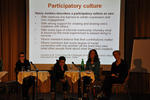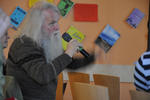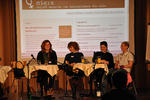What is the role of innovation in activist media cultures?: Civil Media Conference 2009
type=blog
At the beginning of November, Camp GF was busy at the Civil Media Conference in Salzburg, Austria. As an event which brings together media activists, community workers, policy makers, and scholars this annual conference is always a good opportunity to think about the role of technologies and strategies in media activist cultures and beyond. This year's topic was "innovation" and it got me thinking about feminist media communities. We had the opportunity to discuss these ideas in two panels, "Participatory Culture and Technology in on- and offline networks" (with Tea Hvala, Rosa Reitsamer and Sonja Prlic) and "Feminist Media Production in Europe" (with Trouble X, Sarah Diehl, Cristiane Tasinato and Nicole Niedermüller)- more info on these below. We also had the obligatory zine exhibition on show.
In a lot of feminist media scholarship there seems to be this idea that new technologies lead to new subjectivities and forms of activism. In part I can see the logic behind this- for example being able to use the internet as a way of sending out information and announcements is a good way of spreading news which is cheaper and quicker than more conventional means. In theory, it would suggest being able to disseminate feminism more widely and to mobilize more effectively. This website itself is an example of how online technologies can serve as activist tools- it helps us connect and communicate with each other, and to leave traces of our work and ideas for others to pick up.
But from my own media practices, I also see a lot of downfalls from this cyberfeminist boom. Alot of communication between young feminists now takes place online- which can be exhausting, misinterpreted, lost in overfull inboxes, and, dare I say it, often a sublimation of time and energy. Right now I'm rather cynical about the ubiquitous role of online discussion groups and how it creates a lot of noise but not much deed.
As news dissemination, online feminist media has alot of advantages. But what's the impact of creating a new feminist public sphere where people are working predominately as individuals, collaborating virtually and sending their contributions through the wires, but often without ever meeting face to face? Can we create sustainable, strong communities this way? Part of me wonders about what we lose from all this immediacy, ease and always-in-front-of-a-computer sensibility.
In the British Women's Liberation Movements, for example, many women shaped their identities and kinship ties through being community activists . Media and activism was tied to a certain place, time and group of people- who would then feed into bigger feminist infrastructure such as national newsletters or magazines or annual WLM conferences. Having being part of collectives such as Ladyfest organising committees, I see alot is gained through having real time contact. But then, the collective only existed in order to put on an event- then it dissolved, new projects sprung up, and friends who found each other kept in sporadic contact. Do we lack a vision of an ongoing, grassroots feminist force, which tries to create more than the temporary or the virtual?
There are plenty of groups who do just that. But right now I am interested in the rise of media projects headed up by individuals who use the web to network and navigate, and how that creates communities as well as quelling them. When we don't have real time interactions, joint projects, ongoing alternative structures, then how are we developing the tools to jam the status quo and push it off track? I guess I am all up for technological innovation, but I don't want that to be at the expense of old-fashioned notions like community building, face to face communication, and working through conflicts instead of just turning the computer off. Perhaps I am underplaying the role of online feminist media projects in contemporary activism, but if our means our just as important as our ends, then how do we create systems and real-time committments which make this as central as the role of information and communcation itself? Though online media is helpful, do we run the risk of making this the dominant thing we do, the dominate way we network and communicate? Are the intrawebs taking up too much of our time?
-------------------------------------------------------------------------------------------
Documentation of Camp GF at Civil Media 2009
Civil Media Conference: http://www.civilmedia.eu
Discussion Panel: "Feminist Media Production in Europe"
Info: In her research on autonomous media, Annabelle Sreberny-Mohammidi has found, “almost by dint of their existence alone, autonomous media controlled by women with women-defined output offer a challenge to existing hierarchies of power; when these media take up specific issues and campaigns, and align themselves with larger social movements, their political potential is significant”. To further explore such a claim, this panel brings together feminists (of different positions and gender orientations) working in e-zines, comics, magazines, and radio, to find out more about the working practices, innovations and challenges of their work.
With: Trouble X (www.myspace.com/troublextroublex, Germany); Cristiane Tasinato (MigraZine, Austria); Nicole Niedermüller (Radio LoRa,www.lora.ch, Switzerland); and Sarah Diehl (Abortion Democracy, Germany).
Watch video: http://civilmedia09.posterous.com/feminist-media-production-in-europe-pa...
Discussion Panel: Participatory culture and technology in on- and offline networks.
Info: Participatory culture describes a culture where people act as active contributors and producers of media and cultural productions. The term has often been described in relation to Web 2.0, social networking and new media technology. Henry Jenkins describes a participatory culture as one: 1. With relatively low barriers to artistic expression and civic engagement 2. With strong support for creating and sharing one’s creations with others 3. With some type of informal mentorship whereby what is known by the most experienced is passed along to novices 4. Where members believe that their contributions matter 5. Where members feel some degree of social connection with one another (at the least they care what other people think about what they have created). (Confronting the Challenges of Participatory Culture: Media Education for the 21st Century, 2006)
Online communities and networks produce content and have come to interact also in offline spaces. In this panel we discuss examples of participatory culture and the use Web 2.0 in building networks, on- and offline interaction, Internet activism, and the potentials, challenges and barriers of participatory culture and technology. For more information on participatory culture see http://en.wikipedia.org/wiki/Participatory_culture.
With: Rosa Reitsamer (Austria) - ArtMosphere, Dig Me Out• Tea Hvala (Slovenia) - Red Dawns festival, blogger and graffiti: http://www.kudmreza.org/rdece/index_eng.html, http://prepih.blogspot.com/ • Sonja Prlic (Austria) – Frontiers, www.frontiers-game.com, 3d online Computer game to the topic of crossing borders
Listen: http://cba.fro.at/show.php?lang=de&eintrag_id=14797
Photos: David Roethler
- redchidgey's blog
- Login or register to post comments




